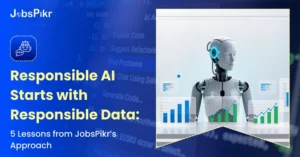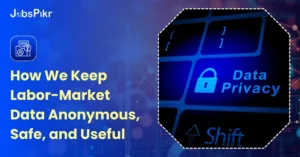- **TL;DR**
- Why Job Data is a Game-Changer for Workforce Analytics
- The Taxonomy of Workforce Analytics
- See JobsPikr in action
- Descriptive Workforce Analytics: Seeing the Landscape
- Diagnostic Workforce Analytics: Understanding the Why
- Predictive Workforce Analytics: Anticipating Shifts
- Prescriptive Workforce Analytics: Turning Insight into Action
- Practical Examples: From Signals to Strategy
- Getting Started with Workforce Analytics Using Job Data
- See JobsPikr in action
- FAQs
**TL;DR**
The workforce is evolving faster than ever, with skills cycles shrinking and jobs transforming by 2030. Traditional workforce analytics tools based only on internal data miss real-time market signals. By leveraging job postings, companies can enhance all four types of workforce analytics: descriptive (what happened), diagnostic (why it happened), predictive (what will happen), and prescriptive (what to do). This external view transforms workforce planning and analytics into a proactive, competitive strategy. JobsPikr delivers structured, API-ready data for faster, more accurate, and scalable workforce intelligence.
The modern workforce landscape shifts with unprecedented velocity. 22% of jobs will be transformed by 2030, while skills depreciation has accelerated to less than 5 years—dropping to just 2.5 years in technology sectors. In this environment of constant change, traditional workforce analytics approaches feel increasingly inadequate.
Most organizations still rely heavily on backward-looking HRIS data, employee surveys, and internal metrics that tell the story of what already happened. While companies like Rippling, ADP, and Workday offer sophisticated internal workplace analytics platforms, they share a fundamental limitation: they operate in a vacuum, isolated from the broader market dynamics that actually drive workforce decisions.
Enter job postings as real-time market signals. Unlike static internal systems, job data provides a forward-looking, external perspective on workforce trends. When AI job mentions surged 56.1% in 2025 following 120.6% growth in 2024, savvy organizations could see this tsunami building months before it hit their talent pipelines. This is the power of external labor market intelligence—it transforms workforce planning and analytics from reactive reporting to predictive strategy.
The global HR analytics market, valued at $3.08 billion in 2024 and projected to reach $8.59 billion by 2032, is evolving rapidly. Yet only 32% of organizations have adopted forecasting capabilities, despite early adopters achieving $13.01 ROI per dollar spent. The key differentiator? Access to real-time, external market signals that traditional internal analytics simply cannot provide.
Ready to put workforce analytics into action?
Why Job Data is a Game-Changer for Workforce Analytics
Traditional workforce analytics face three critical limitations:
The Internal Data Trap
Most HR analytics platforms excel at internal reporting—tracking headcount, analyzing attrition patterns, measuring engagement scores. However, these approaches create what analysts call “analytical blind spots”:
- Reactive insights: Internal data tells you what happened after it’s too late to prevent it
- Limited context: Internal metrics lack market comparison points
- Lagging indicators: Employee surveys and exit interviews capture sentiment weeks or months after triggering events
- Data silos: HRIS systems struggle with integration, exception processing, and maintaining accuracy across departments
The Job Data Advantage
Job postings represent the largest, most standardized dataset about workforce demand globally. Consider these advantages:
Real-time, High-frequency Signals
- JobsPikr processes 275 million job postings globally in real-time across 195 local contexts
- Job posting trends provide insights 2-3 months sooner than classic internal HR cycles
- Market signals emerge immediately when companies adjust hiring priorities
Standardized Across Industries
- Unlike internal systems with varying data schemas, job postings follow consistent patterns
- Skills, compensation, and requirements are comparable across companies and sectors
- Geographic patterns reveal talent movement and market maturation
Scalable Market Intelligence
- External data validates internal findings and reveals broader market trends
- Competitor hiring intensity explains internal attrition patterns
- Skills demand forecasting extends 12-18 months into the future
Market Signal Examples in Action
When cybersecurity job postings increased 34% in Q3 2024 while requiring new cloud certifications, forward-thinking organizations could predict the talent squeeze that materialized months later. Similarly, the surge in fintech postings mentioning blockchain preceded major VC funding rounds by 6-8 weeks, giving smart companies early indicators of industry momentum.
JobsPikr transforms these signals into structured, API-ready data, eliminating the manual scraping and cleaning that typically consumes 60-70% of analytics project time.
The Taxonomy of Workforce Analytics
The evolution from descriptive to prescriptive analytics represents a maturity journey that 80% of HR organizations will complete by early 2025. Yet understanding the four distinct types of workforce analytics and how job data enhances each, remains crucial for strategic implementation.
Source: apploye.com
The Four Core Types:
1. Descriptive Analytics → “What happened?”
- Basic reporting, dashboards, trend identification
- Foundation for all other analytics types
2. Diagnostic Analytics → “Why did it happen?”
- Root cause analysis, correlation identification
- Explains patterns found in descriptive analysis
3. Predictive Analytics → “What will happen?”
- Statistical modeling, forecasting, trend projection
- Anticipates future workforce needs and challenges
4. Prescriptive Analytics → “What should we do?”
- Recommendations, optimization, scenario planning
- Converts insights into actionable strategies
Each type builds upon the previous, creating an analytical progression that transforms raw workforce data into strategic advantage. The key innovation: mapping each analytics type to postings-derived indicators that provide external market validation.
See JobsPikr in action
Request a sample dataset of structured job postings and explore how clean, normalized data powers talent intelligence.
Descriptive Workforce Analytics: Seeing the Landscape
Descriptive analytics forms the foundation of workforce planning and analytics. The “what happened” that every organization must understand before advancing to more sophisticated analysis.
Traditional Descriptive Metrics:
- Headcount by department and role
- Turnover rates and tenure analysis
- Basic demographic reporting
- Cost-per-hire and time-to-fill metrics
Job Data Enhancement:
Demand Trend Analysis
- Number of postings over time serves as proxy for market demand
- Geographic distribution reveals talent hotspots and competitive markets
- Seasonal patterns help predict hiring cycles
Role Taxonomy Insights
- Job title distribution shows market evolution of roles
- Emerging titles signal new skill requirements
- Title standardization reveals industry consolidation trends
Compensation Benchmarking
- Salary mentions enable real-time market benchmarking
- Benefits comparison across similar roles
- Geographic compensation variations
Practical Applications
Market Landscape Questions:
- Which markets show rising demand for cybersecurity professionals?
- How many postings mention hybrid vs. remote work arrangements?
- What’s the average salary range for data scientists in Austin vs. Seattle?
Visual Intelligence: A manufacturing company used job posting data to create heat maps showing industrial engineer demand across the Midwest. When postings spiked 40% in Michigan while remaining flat in Ohio, they redirected their talent acquisition focus and secured key hires before competitors recognized the shift.
Business Impact Metrics:
- Time Savings: 75% reduction in market research time
- Accuracy: 90%+ data quality vs. 60-70% for manual scraping
- Coverage: Global visibility vs. limited regional insights
Diagnostic Workforce Analytics: Understanding the Why
While descriptive analytics reveals what happened, diagnostic analytics explains the underlying causes—the crucial “why” that enables targeted interventions.
Traditional Diagnostic Approaches:
- Exit interview analysis
- Engagement survey correlation
- Performance review pattern analysis
- Internal mobility tracking
Job Data-Driven Diagnostics:
Skill Scarcity Analysis
- Skill cluster analysis reveals why talent is scarce
- Certification requirements explain hiring difficulties
- Technology stack popularity indicates market direction
Competitor Intelligence
- Hiring intensity patterns explain internal attrition
- Compensation escalation reveals market competition
- Geographic expansion signals competitive threats
Role Design Evolution
- Job requirements changes highlight shifting expectations
- Skills combinations reveal emerging hybrid roles
- Experience level trends show market maturation
Case Study Examples
The Cloud Engineering Exodus A fintech company experienced 35% quarterly turnover in their cloud engineering team. Traditional exit interviews cited “career growth” and “compensation.” However, job data diagnostic revealed:
- Competitors increased AWS-certified engineer postings by 67%
- Average salary mentions rose 18% in 6 months
- New postings required certifications the company didn’t provide
Root Cause Identified: Market demand surge for specialized cloud skills, not internal management issues.
The Application Volume Mystery A consulting firm saw 40% decline in applications despite increased job postings. Diagnostic analysis using job data showed:
- Market now demanded Power BI and Tableau skills (mentioned in 78% of similar postings)
- Their postings focused on legacy tools (SAP BI)
- Competitors offered remote work (mentioned in 85% vs. their 0%)
Solution: Updated job descriptions and work arrangements, resulting in 120% application increase.
Advanced Diagnostic Techniques
Correlation Analysis
- Job posting frequency correlates with funding announcements
- Skills demand patterns predict industry consolidation
- Geographic hiring shifts explain talent migration
Market Gap Analysis
- Identifies underserved talent segments
- Reveals geographic arbitrage opportunities
- Highlights skills combinations with low competition
JobsPikr’s diagnostic capabilities enable competitor-aware analysis that internal systems cannot provide, delivering the external market context essential for accurate root cause identification.
Predictive Workforce Analytics: Anticipating Shifts
Predictive analytics represents the strategic frontier where organizations transform from reactive to proactive workforce management. With job data providing forward-looking indicators, predictions become significantly more accurate and actionable.
The Predictive Advantage
Market Growth Indicators:
- AI Engineer jobs grew 143.2% year-over-year
- Prompt Engineer roles increased 95.5%
- Machine Learning positions expanded 35.3%
These weren’t internal trends—they were market-wide patterns visible in job posting data months before impacting individual organizations.
Job Data Predictive Applications:
Emerging Skills Forecasting
- Time-series analysis of skill mentions predicts demand curves
- Technology adoption patterns reveal skills that will become mainstream
- Geographic skills migration shows talent flow patterns
Talent Hotspot Prediction
- Regional hiring volume predicts where talent concentrates
- Cost-of-living vs. salary trends identify emerging markets
- Infrastructure investment correlates with talent demand
Business Outcome Correlation
- Surge in fintech postings precedes VC funding by 6-8 weeks
- R&D hiring spikes predict product launch timing
- Sales hiring patterns forecast market expansion
Predictive Model Examples:
The Austin Tech Boom Prediction
In early 2023, job data showed:
- Austin tech postings increased 28% while Bay Area remained flat
- Average salaries mentioned 15% lower than Silicon Valley
- Major companies began posting Texas-specific roles
Prediction: Austin would become a major tech hub within 18 months.
Outcome: By Q3 2024, Austin tech employment grew 34%, validating the model.
Skills Shortage Forecasting
A pharmaceutical company’s predictive model identified:
- Regulatory affairs postings mentioning AI/ML up 156%
- Traditional compliance roles declining 23%
- Hybrid regulatory-tech positions emerging
Prediction: Critical shortage of AI-enabled regulatory professionals within 12 months.
Action: Launched internal upskilling program 8 months ahead of competition.
ROI of Predictive Analytics
Quantified Benefits:
- 2% reduction in turnover saves $600,000 annually for 2,000-employee companies
- Credit Suisse saved $70 million annually through predictive employee retention
- Best Buy achieved $100,000+ per store annual operating income increase through engagement predictions
Advanced Predictive Capabilities
Scenario Modeling
- “What if” analysis for workforce planning
- Impact assessment of market changes
- Resource allocation optimization
Market Timing
- Optimal timing for talent acquisition campaigns
- Competitive hiring window identification
- Skills investment timing decisions
Prescriptive Workforce Analytics: Turning Insight into Action
Prescriptive analytics represents the culmination of workforce intelligence—converting insights into specific, actionable recommendations that optimize business outcomes.
Traditional Prescriptive Limitations
Most organizations struggle to move beyond reporting and analysis to actual recommendations. Internal data provides limited context for strategic decisions about market positioning, competitive response, or investment priorities.
Job Data-Powered Prescriptive Applications
Strategic Sourcing Optimization
- Benchmarking hiring strategies against market leaders
- Identifying underexplored talent markets with high supply/low competition
- Optimizing job description language based on successful competitor postings
Dynamic Training Investment
- Linking skills demand trends to L&D budget allocation
- Identifying skills with highest ROI potential
- Timing training programs to market demand cycles
Competitive Positioning
- Salary optimization based on real-time market data
- Benefits positioning against competitive offerings
- Geographic expansion decisions based on talent availability
Prescriptive Success Stories
The Data Science Pivot
A consulting firm’s prescriptive analytics recommended:
- Signal: Python demand up 89% in financial services postings
- Diagnosis: Client projects increasingly required advanced analytics
- Prediction: Skills gap would worsen within 6 months
- Prescription: Redirect 40% of training budget to Python/ML upskilling
Result: 85% internal promotion rate for newly trained analysts, $2.1M additional project revenue.
The Geographic Arbitrage Strategy
A SaaS company’s prescriptive model identified:
- Signal: Denver engineering postings 45% lower than Seattle
- Diagnosis: Similar talent pool, significantly lower costs
- Prediction: Denver market would mature within 12 months
- Prescription: Open Denver office immediately, relocate 30% of engineering
Result: 35% reduction in engineering costs, 25% improvement in retention.
Advanced Prescriptive Techniques
Automated Optimization
- Real-time job description adjustments based on posting performance
- Dynamic salary recommendations based on market movements
- Automated sourcing channel allocation
Scenario Planning
- Multiple future state modeling
- Risk assessment for workforce strategies
- Resource allocation across competing priorities
Continuous Optimization
- A/B testing for recruitment strategies
- Performance feedback loops
- Market response measurement
Implementation Framework
Phase 1: Signal Detection
- Monitor key performance indicators
- Identify market pattern changes
- Flag significant deviations
Phase 2: Impact Assessment
- Quantify business impact
- Assess competitive implications
- Calculate intervention costs
Phase 3: Recommendation Generation
- Develop specific action plans
- Prioritize based on ROI potential
- Create implementation timelines
Source: visier.com
Practical Examples: From Signals to Strategy
Understanding how job data flows through each analytics type requires concrete examples that demonstrate the progression from raw signals to strategic action.
Case Study 1: The AI Skills Revolution
Descriptive Signal (What Happened):
- Q1 2024: AI-related job postings increased 120.6%
- Python mentioned in 71% of AI engineer positions
- Design skills now surpass technical skills as most in-demand for AI roles
Diagnostic Analysis (Why It Happened):
- Enterprise AI adoption accelerated post-ChatGPT
- Skills demand shifted from pure technical to hybrid technical-creative
- Communication and leadership entered top 10 AI skills requirements
Predictive Modeling (What Will Happen):
- AI job growth projected to continue at 56.1% through 2025
- Technical-creative hybrid roles will command 25-40% salary premiums
- Geographic demand will shift from Silicon Valley to distributed markets
Prescriptive Action (What To Do):
- Training Initiative: $5M investment in AI-creative skills hybrid programs
- Hiring Strategy: Shifted 60% of AI recruitment budget to non-traditional markets
- Compensation: Preemptively increased AI role salaries by 22%
Outcome: 95% retention rate in AI roles vs. industry average of 67%, secured 15 senior AI professionals before competitors recognized the shift.
Case Study 2: The Remote Work Recalibration
Descriptive Signal:
- Remote work mentions declined 23% in Q4 2024
- “Hybrid” mentions increased 67% in same period
- Geographic requirements returned to 45% of postings
Diagnostic Analysis:
- Companies reassessing pure remote policies
- Collaboration challenges driving hybrid preferences
- Talent pools no longer purely location-agnostic
Predictive Modeling:
- Full remote positions will decrease 35% by end of 2025
- Hybrid roles will become dominant model (65% of postings)
- Geographic salary arbitrage will diminish
Prescriptive Action:
- Office Strategy: Secured flexible office space in 3 secondary markets
- Compensation: Eliminated geographic pay differentials gradually
- Talent Strategy: Focused hiring within 50-mile radius of hub cities
Outcome: 40% improvement in team collaboration metrics, 18% reduction in turnover.
Case Study 3: The Cybersecurity Talent Sprint
Descriptive Signal:
- Cybersecurity postings increased 34% in Q3 2024
- Cloud security certifications mentioned in 78% of senior roles
- Average salary mentions rose 12% quarter-over-quarter
Diagnostic Analysis:
- Major security breaches drove enterprise investment
- Legacy security professionals lacked cloud expertise
- Competition intensified for hybrid skill sets
Predictive Modeling:
- Cybersecurity talent shortage will worsen 40% by Q2 2025
- Cloud-security hybrid roles will command 50%+ premiums
- Geographic competition will extend globally
Prescriptive Action:
- Partnership: Contracted with cybersecurity bootcamp for direct pipeline
- Internal Development: Funded cloud certifications for 30 existing IT staff
- Competitive Intelligence: Monitored competitor hiring patterns monthly
Outcome: Built internal cybersecurity team 8 months ahead of schedule, avoided projected $1.2M security consultant costs.
Getting Started with Workforce Analytics Using Job Data
The journey from traditional internal analytics to job data-enhanced workplace analytics requires systematic implementation, but the barriers are lower than most organizations expect.
Common Implementation Challenges
Data Collection Complexity
- Manual scraping requires 60-70% of project time
- Data quality issues plague homegrown solutions
- Scale limitations prevent comprehensive analysis
Technical Integration
- Legacy HRIS systems resist external data integration
- Analytics teams lack job market domain expertise
- Real-time processing requires significant infrastructure
Skills Gaps
- HR teams comfortable with internal metrics struggle with external data interpretation
- Analytics professionals unfamiliar with workforce domain context
- Leadership unsure how to operationalize insights
Getting Started Framework
Phase 1: Proof of Concept (Weeks 1-4)
- Try sample dataset for specific use case
- Focus on one analytics type (typically descriptive)
- Validate insights against known internal patterns
Phase 2: Pilot Implementation (Weeks 5-12)
- Expand to diagnostic and predictive analytics
- Include competitor intelligence monitoring
- Integrate with existing reporting workflows
Phase 3: Strategic Integration (Weeks 13-24)
- Deploy prescriptive analytics for strategic decisions
- Automate key performance monitoring
- Scale across multiple business units
Success Metrics Framework
Time to Insights
- Target: 75% reduction in market research time
- Measure: Days from question to actionable insight
Decision Quality
- Target: 90% accuracy in predictions vs. internal models
- Measure: Prediction accuracy over 6-month periods
Business Impact
- Target: $13.01 ROI per dollar spent (industry benchmark)
- Measure: Quantified benefits from analytics-driven decisions
The key insight: organizations don’t need to build comprehensive analytics capabilities from scratch. JobsPikr provides the external market intelligence infrastructure that transforms existing internal analytics into a competitive advantage.
Source: aihr.com
The evolution of workforce analytics from backward-looking reporting to forward-thinking strategy represents one of the most significant opportunities in modern business intelligence. While traditional approaches struggle with internal data limitations and reactive insights, job data offers the real-time, external perspective that transforms workforce planning from cost center to strategic advantage.
The four-stage analytics taxonomy provides the roadmap, but job market signals provide the fuel. When 71% of HR executives consider people analytics essential to their strategy, yet only 32% have adopted forecasting capabilities, the competitive window remains wide open.
Organizations that master this external-internal data integration will dominate talent markets that increasingly reward predictive thinking over reactive management. The question isn’t whether to adopt job data-enhanced workforce analytics—it’s whether to lead the transformation or follow in its wake.
The JobsPikr Solution
Immediate Access to Structured Data
- 275 million job postings processed globally in real-time
- 195+ local contexts with cultural and linguistic adaptation
- API-ready format eliminates data preparation overhead
Built-in Analytics Capabilities
- Pre-configured workforce intelligence models
- Industry-specific benchmarks and comparisons
- Geographic talent mapping and competitive analysis
Scalable Implementation
- Start with sample datasets to prove value
- Expand coverage based on business priorities
- Integrate with existing analytics infrastructure
See JobsPikr in action
Request a sample dataset of structured job postings and explore how clean, normalized data powers talent intelligence.
FAQs
1. What are the different types of workforce analytics?
The main types of workforce analytics are descriptive, diagnostic, predictive, and prescriptive. Descriptive looks at what happened, diagnostic explains why, predictive forecasts what will happen, and prescriptive recommends what actions to take. Together, they help HR and business leaders make smarter, data-driven workforce decisions.
2. What is workforce analytics in HR?
Workforce analytics in HR is the practice of using employee and labor market data to understand, predict, and improve workforce outcomes. It goes beyond simple HR metrics to provide insights on hiring, retention, skills demand, and workforce planning.
3. What is the difference between HR metrics and workforce analytics?
HR metrics are basic measurements like headcount, turnover rate, or time-to-hire. Workforce analytics, on the other hand, involves deeper analysis of these metrics to uncover patterns, forecast trends, and guide strategic workforce planning.
4. What role does HRIS play in workforce analytics?
An HRIS (Human Resource Information System) is typically the data source for internal workforce analytics, providing information on employees, roles, payroll, and performance. However, HRIS data is often backward-looking. Combining it with external job market data makes analytics more predictive and strategic.
5. What is the difference between my analytics and workplace analytics?
“My analytics” usually refers to personal productivity tools that give individuals insights into how they spend their time. “Workplace analytics,” in contrast, focuses on the organization-level view, analyzing workforce behaviors, patterns, and performance to support business decisions.
Ready to put workforce analytics into action?




